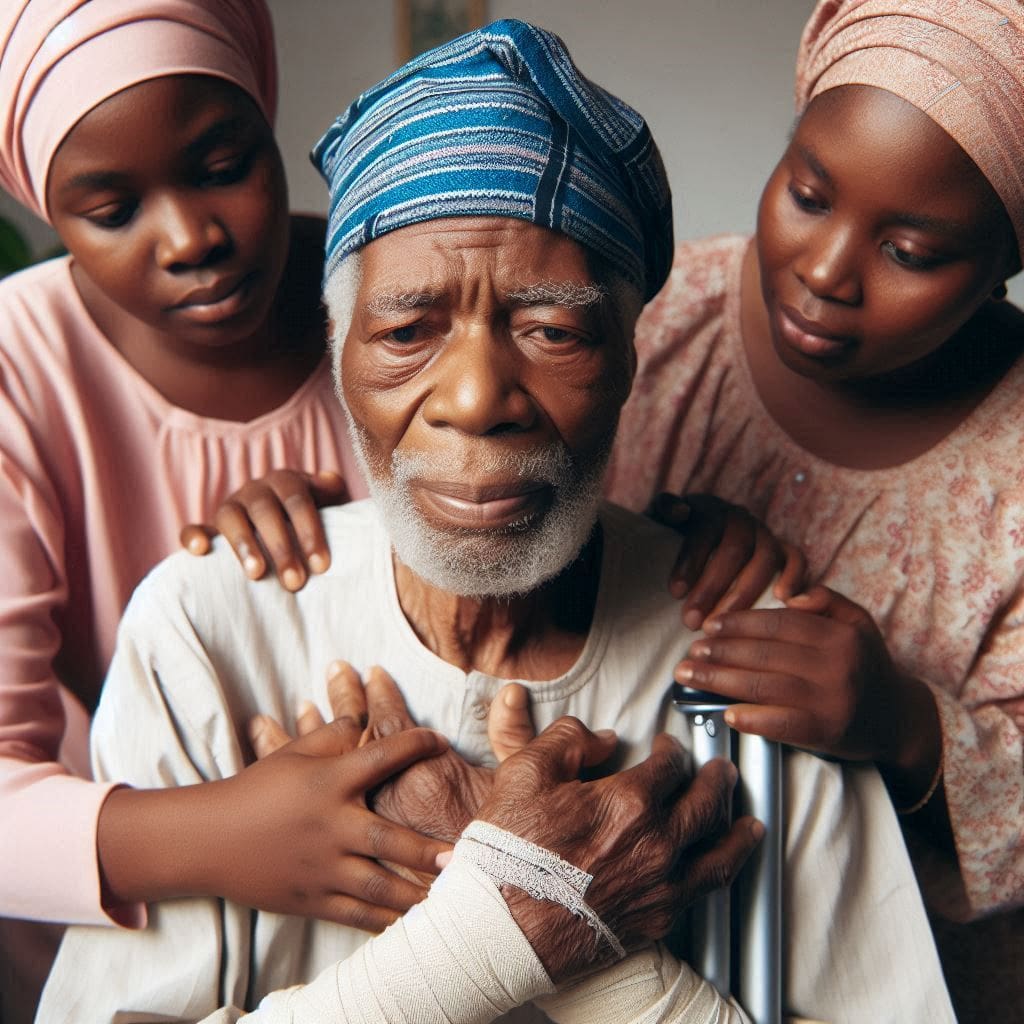
Stroke: A Silent Threat
Stroke is a sneaky health problem that can happen to anyone. It’s like a sudden power outage for your brain.
Imagine your brain as a busy city. A stroke is like cutting off the city’s power, causing chaos and damage. Understanding it is crucial to protect yourself and your loved ones.
In this guide, we will help you understand what it is, how to spot the symptoms quickly, and what you can do to prevent it.
Whether you are caring for a loved one or just want to be prepared, this easy-to-understand information is vital for everyone. Learn how to protect yourself and others from this silent killer.
What is a Stroke?
A stroke happens when blood flow to a part of the brain is blocked or reduced, which stops brain tissue from getting oxygen and nutrients. This can cause brain cells to die within minutes. It’s a medical emergency that needs immediate attention.
Why Older Adults are More Affected
Additionally, older adults are more likely to have other risk factors for it, such as high blood pressure, diabetes, and heart disease.
Risk Factors for Stroke
Understanding the risk factors for stroke can help you take steps to reduce your risk.
Here are the main factors:
Health Conditions
- High Blood Pressure:
- Diabetes:
- Increases its risk by damaging blood vessels and causing other health issues.
- Heart Disease:
- High Cholesterol:
- Leads to plaque build-up in the arteries, which can block blood flow to the brain.
Lifestyle Factors
- Smoking:
- Damages blood vessels and increases blood pressure, raising its risk.
- Poor Diet:
- Eating too much salt, fat, and sugar can lead to high blood pressure, high cholesterol, and obesity.
- Lack of Exercise:
- Not being active can contribute to high blood pressure, obesity, and poor overall health.
- Excessive Alcohol Consumption:
Other Factors
- Age:
- Its risk increases as you get older.
- Family History:
- Gender:
Causes of Stroke
It can be caused by:
- Blocked Arteries (Ischemic Stroke): Most strokes are caused by a blockage in an artery that supplies blood to the brain. This can happen because of a blood clot or a build-up of fatty deposits (plaque).
- Leaking or Bursting of a Blood Vessel (Hemorrhagic Stroke): This type occurs when a blood vessel in the brain leaks or bursts, leading to bleeding in or around the brain. This can be caused by high blood pressure, trauma, or an aneurysm.
- Transient Ischemic Attack (TIA): Sometimes called a mini-stroke, a TIA is a temporary blockage of blood flow to the brain. It doesn’t cause permanent damage but is a warning sign of a future stroke.
Easy Ways to Recognize a Stroke in a Person
Recognizing it quickly can save lives and reduce long-term effects. Here are simple steps to identify it:
Use the B.E. F.A.S.T. Method
- Balance Loss (B):
- Check if the person has a sudden loss of balance or coordination. Ask them to walk or stand and observe if they are unsteady.
- Eyesight Changes (E):
- Ask if the person has sudden blurred or double vision or a sudden loss of vision in one or both eyes.
- Face Drooping (F):
- Ask the person to smile. Check if one side of the face droops or looks uneven.
- Arm Weakness (A):
- Ask the person to raise both arms. See if one arm drifts downward or can’t be raised.
- Speech Difficulty (S):
- Ask the person to repeat a simple sentence, like “The sky is blue.” Listen for slurred or strange speech.
- Time to Call for Help (T):
- If you notice any of these signs, call emergency services immediately. In Nigeria, dial 112 or the local emergency number for an ambulance.
Other Symptoms of Stroke
Recognizing its symptoms early can save lives. Common signs include:
- Sudden numbness or weakness in the face, arm, or leg, especially on one side of the body.
- Sudden confusion, trouble speaking, or understanding speech.
- Sudden trouble seeing in one or both eyes.
- Sudden trouble walking, dizziness, loss of balance, or lack of coordination.
- Sudden severe headache with no known cause.
Negative Impacts of Stroke on Mental Health and Overall Well-Being
It can have many negative effects on a person’s mental health and overall well-being. Here are some key impacts:
Mental Health Effects
- Depression:
- Many stroke survivors feel sad and hopeless, leading to depression.
- Anxiety:
- Worry and fear about having another stroke can cause anxiety.
- Cognitive Challenges:
- Problems with memory, thinking, and concentration are common after a stroke.
- Emotional Changes:
- It can affect emotions, leading to mood swings or feelings of frustration and anger.
Overall Well-Being Effects
- Physical Limitations:
- It can cause weakness or paralysis on one side of the body, making daily activities difficult.
- Speech Problems:
- Some stroke survivors have trouble speaking or understanding language, impacting communication.
- Fatigue:
- Feeling extremely tired and having low energy is common after a stroke.
- Loss of Independence:
- Difficulty with movement and daily tasks can lead to a loss of independence and require help from others.
- Social Isolation:
Medical Treatments for Stroke
Emergency Treatment
- Quick Action: Fast treatment can save brain cells. For ischemic strokes (caused by blood clots), doctors may use clot-busting drugs to restore blood flow. For hemorrhagic strokes (caused by bleeding), surgery may be needed to repair the blood vessel.
Medications
- Blood Thinners: These medications help prevent new clots from forming and reduce the risk of future strokes.
- Cholesterol-Lowering Drugs: These help reduce plaque build-up in the arteries, lowering its risk.
- Blood Pressure Medications: Controlling high blood pressure is crucial in preventing strokes.
Rehabilitation
- Physical Therapy: Helps patients regain strength and coordination.
- Occupational Therapy: Teaches new ways to perform daily activities.
- Speech Therapy: Assists in recovering communication skills if speech is affected.
Traditional Treatments for Stroke
Some cultures use traditional treatments alongside medical care. These can include:
- Herbal Remedies: Certain herbs are believed to improve blood circulation and brain function.
- Acupuncture: This ancient practice involves inserting thin needles into specific points on the body to promote healing and well-being.
- Massage Therapy: Massage can help reduce stress and improve circulation, which may be beneficial for its recovery.
Preventing Stroke
Preventing it involves making healthy lifestyle choices and managing health conditions that increase its risk.
Here are some tips:
- Control Blood Pressure: High blood pressure is a major risk factor for it. Regular check-ups and medication can help keep it under control.
- Manage Diabetes: Keep blood sugar levels in check through diet, exercise, and medication.
- Eat a Healthy Diet: Focus on eating plenty of fruits, vegetables, whole grains, and lean proteins. Avoid foods high in saturated fat, cholesterol, and sodium.
- Exercise Regularly: Aim for at least 30 minutes of moderate exercise most days of the week.
- Quit Smoking: Smoking significantly increases the risk of stroke. Quitting can improve overall health.
- Limit Alcohol: Drink in moderation. Excessive drinking can increase blood pressure and the risk of having it.
- Maintain a Healthy Weight: Being overweight can increase its risk. A balanced diet and regular exercise can help.
Support for Living with a Stroke Patient

Living with a stroke patient can be challenging, but there are many ways to provide support.
Here are some key areas to focus on:
Medical Support
- Regular Check-Ups:
- Ensure the patient sees their doctor regularly for follow-up care.
- Medication Management:
- Help the patient take their medications on time and keep track of their prescriptions.
Physical Support
- Assist with Mobility:
- Help the patient move around safely, using aids like walkers or wheelchairs if needed.
- Physical Therapy:
- Encourage and assist with exercises recommended by a physical therapist to regain strength and mobility.
Emotional Support
- Provide Encouragement:
- Offer positive reinforcement and celebrate small victories to boost their morale.
- Be Patient:
- Understand that recovery takes time and be patient with their progress.
- Counseling:
- Consider professional counseling to help the patient cope with emotional changes and depression.
Daily Living Support
- Assist with Daily Activities:
- Help with tasks like bathing, dressing, and eating if the patient has difficulty.
- Modify the Home:
- Make changes to the home to ensure it is safe and accessible, such as installing grab bars and ramps.
Social Support
- Encourage Social Interaction:
- Help the patient stay connected with friends and family to prevent isolation.
- Join Support Groups:
- Find local or online support groups where the patient can share experiences and gain encouragement.
Educational Support
- Learn About Stroke:
- Educate yourself and the patient about stroke, its effects, and recovery strategies.
- Provide Information:
- Share helpful resources and information about recovery and support services.
Conclusion
Stroke is a serious health issue that can strike suddenly, causing significant changes to a person’s life. It’s crucial to understand what it is, recognize its symptoms quickly, and know how to prevent it.
By being aware of the risk factors, symptoms, and treatments, you can better protect yourself and your loved ones from this silent threat.
Understanding it helps in recognizing its early signs, such as sudden balance loss, changes in eyesight, face drooping, arm weakness, and speech difficulties. Prompt action is key, and seeking medical help immediately can make a big difference.
For those living with a stroke patient, providing medical, physical, emotional, and daily support is essential. This includes managing medications, assisting with mobility, offering emotional encouragement, and ensuring a safe and supportive home environment.
Taking steps to prevent it, such as controlling blood pressure, managing diabetes, eating a healthy diet, exercising regularly, and avoiding smoking and excessive alcohol, can significantly reduce the risk.
In summary, being informed and proactive about it can help save lives and improve recovery outcomes. Share this knowledge with others to spread awareness and support those affected by it.



